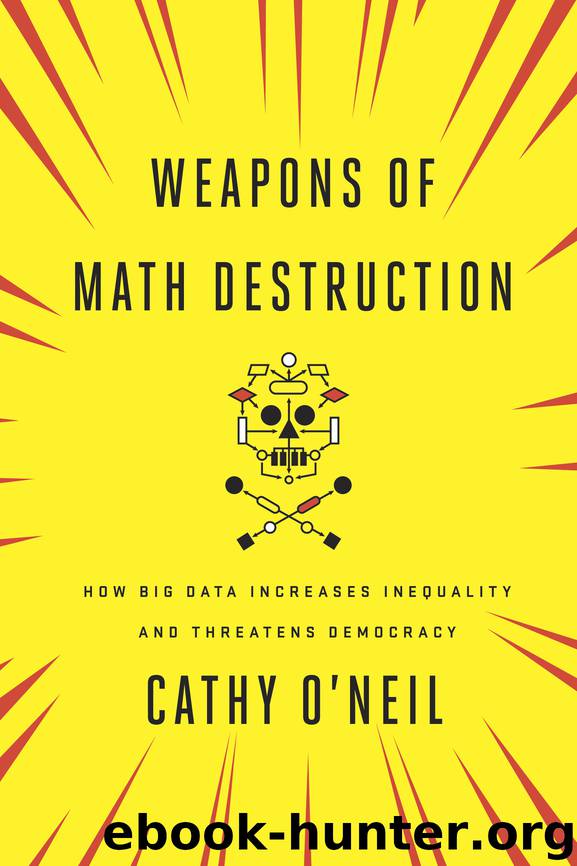Weapons of Math Destruction by Cathy O'Neil

Author:Cathy O'Neil
Language: eng
Format: epub
Publisher: Crown/Archetype
Published: 2016-09-05T16:00:00+00:00
In 2008, just as the great recession was approaching, a San Francisco company called Cataphora marketed a software system that rated tech workers on a number of metrics, including their generation of ideas. This was no easy task. Software programs, after all, are hard-pressed to distinguish between an idea and a simple string of words. If you think about it, the difference is often just a matter of context. Yesterday’s ideas—that the earth is round, or even that people might like to share photos in social networks—are today’s facts. We humans each have a sense for when an idea becomes an established fact and know when it has been debunked or discarded (though we often disagree). However, that distinction flummoxes even the most sophisticated AI. So Cataphora’s system needed to look to humans themselves for guidance.
Cataphora’s software burrowed into corporate e-mail and mes saging in its hunt for ideas. Its guiding hypothesis was that the best ideas would tend to spread more widely through the network. If people cut and pasted certain groups of words and shared them, those words were likely ideas, and the software could quantify them.
But there were complications. Ideas were not the only groups of words that were widely shared on social networks. Jokes, for example, were wildly viral and equally befuddling to software systems. Gossip also traveled like a rocket. However, jokes and gossip followed certain patterns, so it was possible to teach the program to filter out at least some of them. With time, the system identified the groups of words most likely to represent ideas. It tracked them through the network, counting the number of times they were copied, measuring their distribution, and identifying their source.
Very soon, the roles of the employees appeared to come into focus. Some people were idea generators, the system concluded. On its chart of employees, Cataphora marked idea generators with circles, which were bigger and darker if they produced lots of ideas. Other people were connectors. Like neurons in a distributed network, they transmitted information. The most effective connectors made snippets of words go viral. The system painted those people in dark colors as well.
Now, whether or not this system effectively measured the flow of ideas, the concept itself was not nefarious. It can make sense to use this type of analysis to identify what people know and to match them with their most promising colleagues and collaborators. IBM and Microsoft use in-house programs to do just this. It’s very similar to a dating algorithm (and often, no doubt, has similarly spotty results). Big Data has also been used to study the productivity of call center workers.
A few years ago, MIT researchers analyzed the behavior of call center employees for Bank of America to find out why some teams were more productive than others. They hung a so-called sociometric badge around each employee’s neck. The electronics in these badges tracked the employees’ location and also measured, every sixteen milliseconds, their tone of voice and gestures. It recorded when people were looking at each other and how much each person talked, listened, and interrupted.
Download
This site does not store any files on its server. We only index and link to content provided by other sites. Please contact the content providers to delete copyright contents if any and email us, we'll remove relevant links or contents immediately.
| Biomathematics | Differential Equations |
| Game Theory | Graph Theory |
| Linear Programming | Probability & Statistics |
| Statistics | Stochastic Modeling |
| Vector Analysis |
Modelling of Convective Heat and Mass Transfer in Rotating Flows by Igor V. Shevchuk(6209)
Weapons of Math Destruction by Cathy O'Neil(5783)
Factfulness: Ten Reasons We're Wrong About the World – and Why Things Are Better Than You Think by Hans Rosling(4457)
Descartes' Error by Antonio Damasio(3141)
A Mind For Numbers: How to Excel at Math and Science (Even If You Flunked Algebra) by Barbara Oakley(3082)
Factfulness_Ten Reasons We're Wrong About the World_and Why Things Are Better Than You Think by Hans Rosling(3029)
TCP IP by Todd Lammle(2985)
Applied Predictive Modeling by Max Kuhn & Kjell Johnson(2865)
Fooled by Randomness: The Hidden Role of Chance in Life and in the Markets by Nassim Nicholas Taleb(2837)
The Tyranny of Metrics by Jerry Z. Muller(2821)
The Book of Numbers by Peter Bentley(2745)
The Great Unknown by Marcus du Sautoy(2518)
Once Upon an Algorithm by Martin Erwig(2459)
Easy Algebra Step-by-Step by Sandra Luna McCune(2436)
Lady Luck by Kristen Ashley(2387)
Practical Guide To Principal Component Methods in R (Multivariate Analysis Book 2) by Alboukadel Kassambara(2361)
Police Exams Prep 2018-2019 by Kaplan Test Prep(2335)
All Things Reconsidered by Bill Thompson III(2244)
Linear Time-Invariant Systems, Behaviors and Modules by Ulrich Oberst & Martin Scheicher & Ingrid Scheicher(2213)
